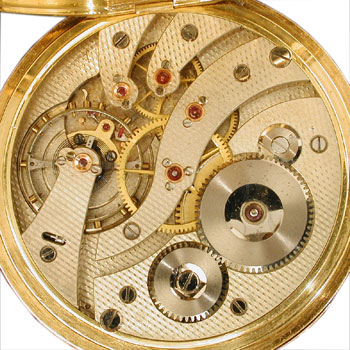Collectors Weekly: Before that, were people making pocket watches in America at all?
McIntyre: There were some brothers in Connecticut called the Pitkins who made some watches before that, and there was a family near Worcester, Mass. called the Goddards. Luther Goddard and Benjamin Goddard and Parley Goddard made watches, but they were handmade watches. The Pitkin watches used some machinery and were a first stab at doing it, but they didn’t do it all that well, so it didn’t really take off, and one of them went insane trying and killed himself.
Collectors Weekly: Once Waltham introduced precision manufacturing, how did the quality of the watches change?
McIntyre: The point of manufacturing them was that if you made the same part over and over again, you could make it better than if you had to make each one from scratch each time. They had special machinery that would make gears and special machinery that would make shafts and plates and little springs and all the various pieces of the watch, the screws and so forth, but it took a long time to develop all those machines.
http://www.collectorsweekly.com/articles/an-interview-with-antique-pocket-watch-collector-tom-mcin
The very first pocket watches they made with machinery were about as good as the regular run-of-the-mill watches that were being made in Europe, but they weren’t nearly as good as the very best European watchmakers could make them. They were better than any that were being made in this country because we just didn’t have the tradition of the crafts here, but the English and Swiss and French made very fine watches in the early 19th century, and we didn’t make any that good probably until at least 10 or 15 years after we began manufacturing them here.
At first they were figuring out the machines. They were figuring out how heavy they had to make them to be able to cut the same shape reliably every time and all sorts of things about how to build production machinery that they didn’t really know. If you’re going to make parts automatically and have clamping jaws opening and closing and picking things up and moving them around by machinery, then you need to have a great, strong, and stable base for that machine.
I think they were surprised at how heavy they had to make the machinery and it took them a few years to work all that out, but by the early 1870s, the watches that were being made at Waltham were winning all of the prizes around the world for the best watches. It only took them about 20 years.
They were still making them by hand in Europe until then, and then a fellow from Switzerland came over to our centennial exposition in 1876 and saw the Waltham watches being made by machinery. He went back to Switzerland and tried to persuade the Swiss to do that. It took quite a few years to persuade them, but a couple of Americans went over there and set up factories, and then the Swiss reports said that the machinery was the way to go.
The Swiss developed a very similar style of making watches by machine, but not with large factories like the Americans had. So the Swiss never did get to making millions of watches a year, at least in the 19th century, whereas the largest American watch companies were making more than a million watches a year.
The Swiss are known for their craftsmanship, however. They had an edge in terms of assembling the watches and adjusting them and that sort of thing. Once they got to using the machinery, they could produce some very wonderful things. They caught up with the Americans in the early 20th century and then passed them. That, plus a couple of wars where the Swiss didn’t fight and we did, essentially finished off the American watch industry.
The last American watch factory folded up in the 1960s. Recently a fellow started making watches in America, complete watches but on a very small scale, but that only started a couple of years ago. They’re mostly wristwatches because there’s not a big market for pocket watches. Nobody wears vests anymore.
There are some craftsmen, mostly in England and Switzerland, who occasionally make a very special pocket watch, and Patek Philippe, which is one of the top wristwatch companies, also occasionally makes pocket watches. The Patek Philippe caliber 89, which is probably the most famous recent production, was made back in 1989 and cost $2.5 million, but it was a very special watch. It could tell you what day Easter was going to fall on 50 years from now.

No comments:
Post a Comment